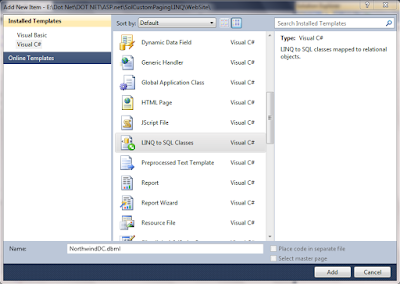In some scenario that requires we have to find a control within a ControlTemplate. To do that, you use Template.FindName method.
Let see how to find control from ControlTemplate.
Step 1
Create a WPF application and give a solution name as SolFindControlInControlTemplate.
Step 2
Add a button control on window,it is look like this
Step 3
Create a simple ControlTemplate for button control,it is look like this
Step 5
Find a rectangle control in the ControlTemplate of btnColor and change the rectangle color,it is look like
Full Code
1. XAML Code
2. Code behind
Run the project.
Download
Download Source Code
Let see how to find control from ControlTemplate.
Step 1
Create a WPF application and give a solution name as SolFindControlInControlTemplate.
Step 2
Add a button control on window,it is look like this
<Window x:Class="SolFindControlInControlTemplate.MainWindow" xmlns="http://schemas.microsoft.com/winfx/2006/xaml/presentation" xmlns:x="http://schemas.microsoft.com/winfx/2006/xaml" Title="Find Control in Control Template" Height="350" Width="525"> <Grid> <Button Content="ChangeColor" Height="43" HorizontalAlignment="Left" Margin="155,126,0,0" Name="btnColor" VerticalAlignment="Top" Width="208"/> </Grid> </Window>
Step 3
Create a simple ControlTemplate for button control,it is look like this
<Window.Resources> <ControlTemplate x:Key="BtnControlTemplate" TargetType="Button"> <Grid> <Rectangle x:Name="ButtonRecTangle" Stroke="Black" StrokeThickness="3" RadiusX="10" RadiusY="10" Fill="Orange"> </Rectangle> <!--For Display Text(Content) in button --> <Viewbox> <!--set the button text which user will define on button--> <ContentControl Content="{TemplateBinding Button.Content}"></ContentControl> </Viewbox> </Grid> </ControlTemplate> </Window.Resources>
Step 4
Apply ControlTemplate on button control,it is look like this
<Grid> <Button Content="ChangeColor" Height="43" HorizontalAlignment="Left" Margin="155,126,0,0" Name="btnColor" VerticalAlignment="Top" Width="208" Template="{StaticResource BtnControlTemplate}" Click="btnColor_Click" /> </Grid>
Step 5
Find a rectangle control in the ControlTemplate of btnColor and change the rectangle color,it is look like
private void btnColor_Click(object sender, RoutedEventArgs e) { try { // Find a rectangle control within a ControlTemplate by using Template.FindName method Rectangle RecTangleObj =(Rectangle) btnColor.Template.FindName("ButtonRecTangle", btnColor); // Fill the rectangle color RecTangleObj.Fill = System.Windows.Media.Brushes.Red; } catch (Exception ex) { MessageBox.Show(ex.Message); } }
Full Code
1. XAML Code
<Window x:Class="SolFindControlInControlTemplate.MainWindow" xmlns="http://schemas.microsoft.com/winfx/2006/xaml/presentation" xmlns:x="http://schemas.microsoft.com/winfx/2006/xaml" Title="Find Control in Control Template" Height="350" Width="525"> <Window.Resources> <ControlTemplate x:Key="BtnControlTemplate" TargetType="Button"> <Grid> <Rectangle x:Name="ButtonRecTangle" Stroke="Black" StrokeThickness="3" RadiusX="10" RadiusY="10" Fill="Orange"> </Rectangle> <!--For Display Text(Content) in button --> <Viewbox> <!--set the button text which user will define on button--> <ContentControl Content="{TemplateBinding Button.Content}"></ContentControl> </Viewbox> </Grid> </ControlTemplate> </Window.Resources> <Grid> <Button Content="ChangeColor" Height="43" HorizontalAlignment="Left" Margin="155,126,0,0" Name="btnColor" VerticalAlignment="Top" Width="208" Template="{StaticResource BtnControlTemplate}" Click="btnColor_Click" /> </Grid> </Window>
2. Code behind
using System; using System.Collections.Generic; using System.Linq; using System.Text; using System.Windows; using System.Windows.Controls; using System.Windows.Data; using System.Windows.Documents; using System.Windows.Input; using System.Windows.Media; using System.Windows.Media.Imaging; using System.Windows.Navigation; using System.Windows.Shapes; namespace SolFindControlInControlTemplate { public partial class MainWindow : Window { public MainWindow() { InitializeComponent(); } private void btnColor_Click(object sender, RoutedEventArgs e) { try { // Find a rectangle control within a ControlTemplate by using Template.FindName method Rectangle RecTangleObj =(Rectangle) btnColor.Template.FindName("ButtonRecTangle", btnColor); // Fill the rectangle color RecTangleObj.Fill = System.Windows.Media.Brushes.Red; } catch (Exception ex) { MessageBox.Show(ex.Message); } } } }
Run the project.
Download
Download Source Code





